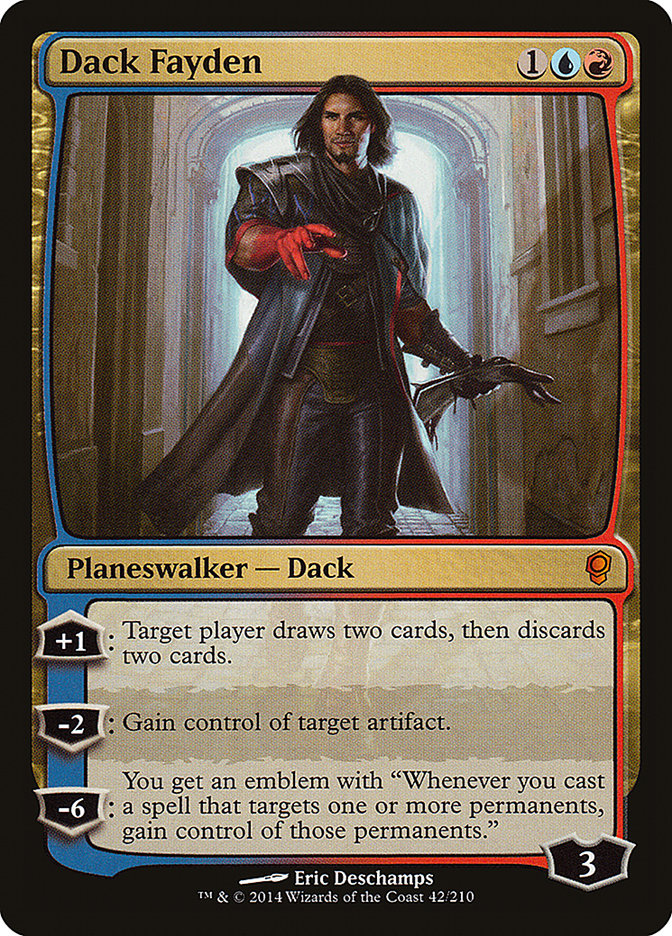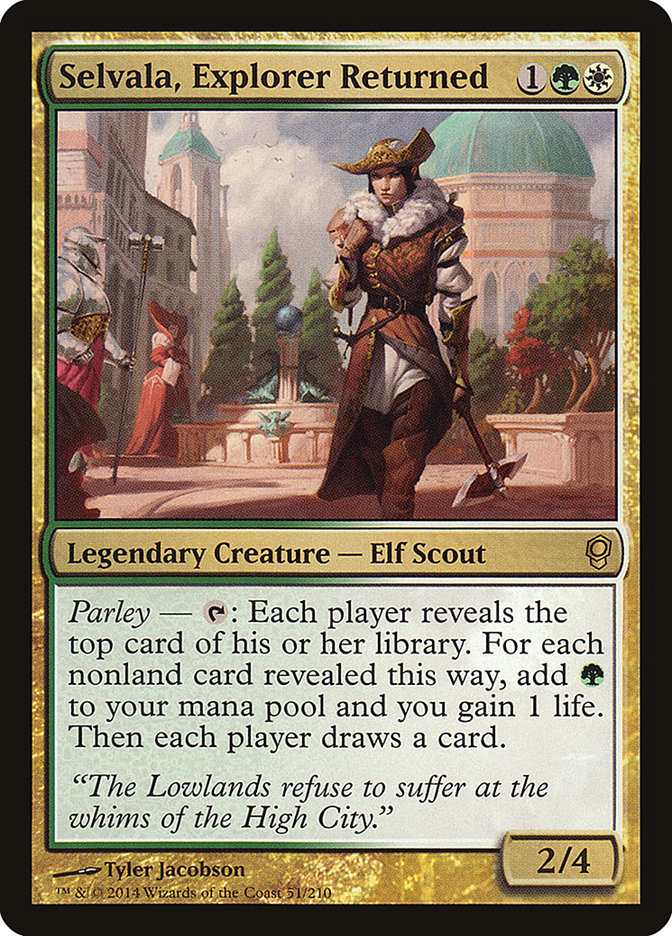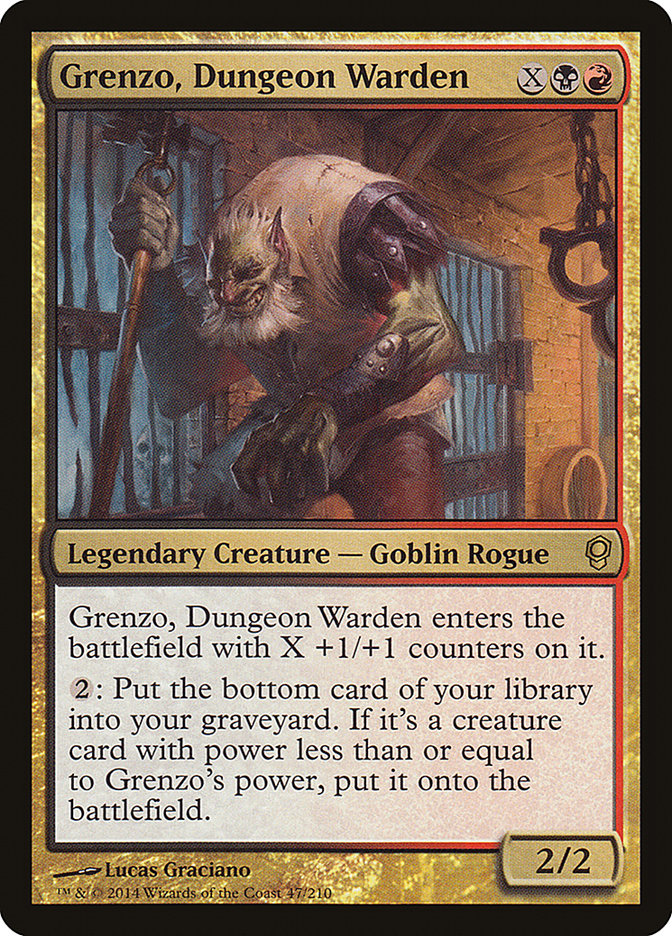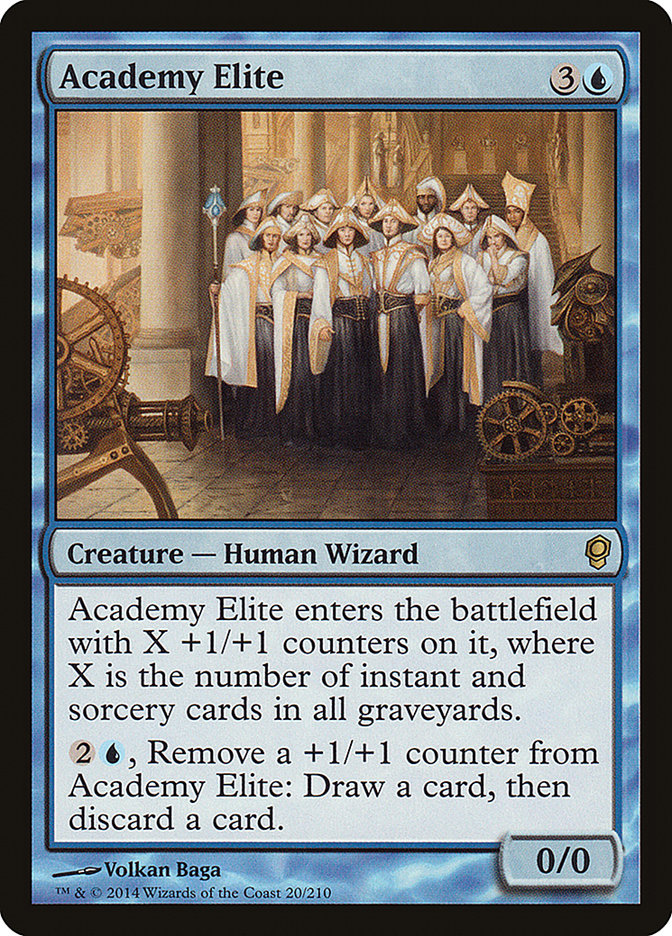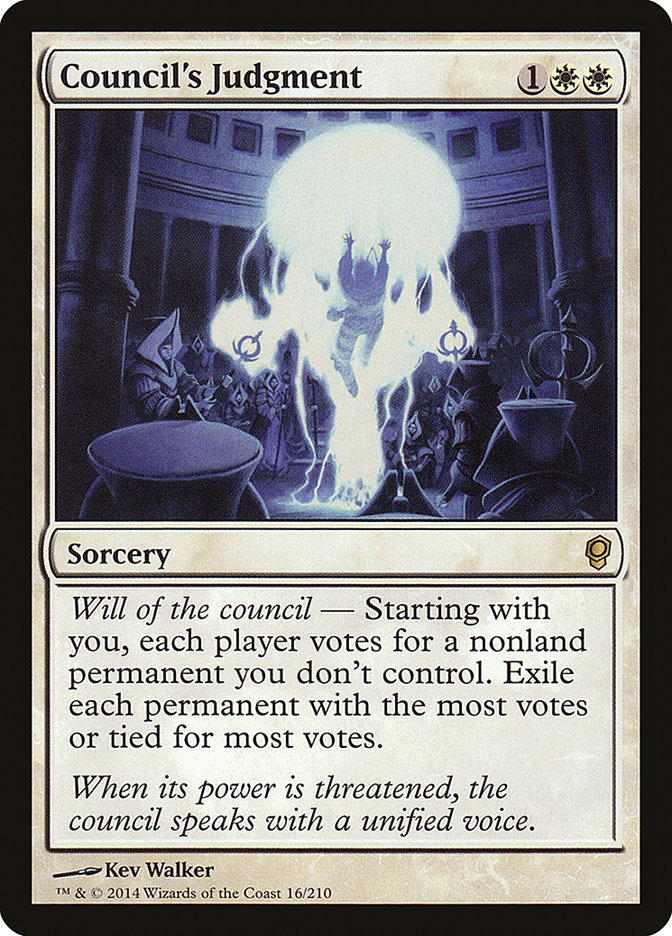As someone who rarely plays either limited or truly casual, kitchen table Magic – I’d usually rather keep jamming those sweet constructed decks; arbitrary
“that ain’t fun” deck construction rules just don’t work for me – I don’t think I’m exactly the ideal target of
WotC
the Illuminati’s latest activity out of the shadows. And yet, they might have been just for me. There’s a dark secret I have to share: I enjoy
chaos and crazy things happening in my games more than almost anything else. So I succumbed to the lure of the Conspiracy experience instantly when the
opportunity came up. And darn it if that set isn’t the most fun I’ve had in multiplayer possibly ever.
The drafting experience already provides good laughs – you gotta love the Cogwork Librarian loop! – conspiracies allow you to try and do weird things – I
ended up playing Fact or Fiction with no blue mana sources and actively trying to draft Pillarfield Oxen of all things. I also built my deck around the
lategame plan of using Reito Lantern to set up the good old Soldevi Digger loop (Yes, I always assume multiplayer will be grindy). While things
didn’t go quite that long, I managed to surprise win our five-man pod with the devious plan of defending with a 3/5 Pillarfield Ox (thanks, Muzzio) and
similar all-stars such as Zombie Goliath backed by a couple of removal spells.
As you might realize, my deck looked pretty terrible, at least judging from the creature quality. That worked out perfectly though, as everybody else blew
their resources fighting one another while I sat back shouting dire warnings about some of the more threatening cards in play, ready to pounce once things
had spiraled to a position where someone else was ready to take the game. My secret plans came to fruition perfectly.
With one opponent dead and another ready to succumb on his draw step – Altar of Dementia is pretty ridiculous in this format actually – my time to strike
from the shadows finally arrived. My motley crew of Oxen and Zombies ran in to finish off one opponent, conveniently leaving exactly two other players when
I slammed my first pick Magister of Worth onto the board, ready to vote twice due to my alliance with King Brago’s Representative and ensure the board was
clear on something like turn 20. With one of my two leftover opponents ready to die to decking, that left just one adversary to fight. The immediate action
of hasty Twisted Abominations ended things in my favor over the course of two turns, leaving everybody else to shake heads commenting how they had believed
all game I had simply ended up with an utterly terrible deck. Thank you, Pillarfield Ox, you’re the man!
Over all, I have to say Conspiracy is totally sweet. There is enough weirdness and unusual stuff going on to make it the perfect multiplayer experience. In
fact, a Conspiracy draft doesn’t really feel like a normal game of Magic (maybe it does for all those dedicated casual multiplayer fans amongst you) but
rather resembles playing a board game that just happens to use MTG rules to function. If you want to spend a fun evening of gaming, I certainly suggest you
give the set a shot.
Back to the Real Game
However, you aren’t here looking for casual multiplayer articles, are you? You’re looking for the Eternal Spike fix, right? Well, come over here to the
back table in the dark corner with the good view of the door. I know a couple of conspirators who just might be worth recruiting. Let me introduce you:
While far from busted, Bottled Cloister appears in Legacy once in a while, usually in MUD-style decks. For the same four mana, Coercive Portal provides a
different way to draw an extra card every turn. It trades the ability to protect your hand from discard on your opponent’s turn for the immunity to the
removal blow-out (having your Cloister destroyed while the hand is exiled is no fun). So if your main reason to run Cloister was as a way to keep
drawing cards, you’re probably better off going through the Portal while visiting the Cloister is what you want to do when aiming to fight discard. No new
world order but definitely a nice extra-option to exert minor influence through tweaking.
Come meet the greatest thief in the multiverse – make sure you keep an eye on your valuables, though. So what does Dack bring to the table? A three mana
price tag is definitely promising and a plus ability that draws cards (well, trades dead cards for fresh ones) drives that potential home. The minus
ability isn’t the greatest in Legacy (though stealing a Jitte or Batterskull is kinda nice), but seems awesome in Vintage (Sol Ring, Time Vault and almost
any reasonable Tinker target are perfect baubles to liberate). Finally, Dack’s emblem teaching you to steal just as well as he does is unlikely to be
particularly good – how many spells that target things and don’t get rid of them are you playing in constructed, exactly? We don’t generally play
planeswalkers for their ultimates anyway, so where does that leave us?
Playing Dack for either of the stealing abilities alone is unlikely to be worth it. For him to really steal the show, your deck needs to want to loot a lot. You also want to be playing a reasonably long game, though –
disqualifying Dredge and Reanimator – as otherwise you’re just better off with the sorcery one-shots. To me that screams for one particular co-conspirator:
Goblin Welder. Maybe I just love the little Goblin far too much, but Dack feels as if he was tailor-made to bring back his glory days. If you’ve been
playing for long enough, you might remember one-time Vintage power house Control Slaver, crippled ever since Thirst for Knowledge has been restricted
(Welding around expensive artifacts is much less powerful if you actually have to cast them first). Dack might be exactly the tool that deck needed to pop
back up.
For the same three mana – though sadly at sorcery speed – you don’t ever get to draw three, discard one. The planeswalker on the board has a lot of value
in itself though, (I did mention Tinker, didn’t I?) and while sitting there and posing a threat, he works in parallel to filter your draws and stock the
graveyard with both Welder-targets and a lot of cards to Yawgmoth’s Will back. Something along these lines definitely feels worth exploring:
Creatures (6)
Planeswalkers (3)
Lands (15)
Spells (36)
- 2 Sensei's Divining Top
- 1 Brainstorm
- 4 Mana Drain
- 1 Vampiric Tutor
- 1 Mystical Tutor
- 1 Yawgmoth's Will
- 4 Force of Will
- 1 Mana Vault
- 1 Sol Ring
- 1 Demonic Tutor
- 1 Time Walk
- 1 Ancestral Recall
- 1 Mana Crypt
- 1 Time Vault
- 1 Gifts Ungiven
- 1 Merchant Scroll
- 1 Thirst for Knowledge
- 1 Mindslaver
- 1 Tinker
- 1 Voltaic Key
- 1 Black Lotus
- 1 Lotus Petal
- 1 Mox Emerald
- 1 Mox Jet
- 1 Mox Pearl
- 1 Mox Ruby
- 1 Mox Sapphire
- 2 Mental Misstep

That’s just a rough draft that likely needs both a couple of ways to interact with the board in the maindeck as well as additional tuning, but given how
little I actually know about the current Vintage metagame, I don’t think I’m the person to be doing that. Hopefully someone with more opportunity to
actually play the format decides to run with this one though. There’s a reason Goblin Welder was once considered a clear include in the ten best creatures
ever printed (competing for top spot, actually) and having him team up with the greatest thief in the multiverse might re-unlock the potential he proved to
have in the past.
I’m not sure what kind of deck wants a three mana mana elf that makes both players draw a card whenever it is used, but having access to this as a
repeatable effect is actually reasonably powerful. Seeing the amount of play Temple Bell sees – none – the chances of Selvala are quite low, but if you
already want Temple Bell for some reason, you might want to take a look at the Returned Explorer.
Not a card you expected me to mention? I can’t say that I’m surprised. With that X and two colored symbols in the upper right corner, Grenzo looks
extremely clunky on first sight. However, what we should really be evaluating is this:
RB
Legendary Creature – Goblin
2/2
2: If the bottom card of your library is a creature, put it into play.
Kicker X: Put X +1/+1 counters on Grenzo.
Seeing the potential yet? A 2/2 bear that can be found with Goblin Matron and will stick around when revealed to Goblin Ringleader isn’t the most terrible
of cards to put in Goblins already, and because nothing in Goblins has more than two points of power, it provides you with a lategame plan that is more
overpowering than even Goblin Ringleader chaining given you have enough lands. Because Grenzo allows you to continually pay mana for more goblins, your
opponent needs to either deal with it on the spot or kill you immediately. If they don’t, just spending all your mana on Grenzo-activations every turn is
likely to run away with the game in short order while you build up a hand to play with in case they manage to deal with the Grenzo’ed up board.
The “kicker” even gives Goblins access to a large creature. There are numerous games where the deck would kill for a six mana 6/6 – if only to stop
Tarmogoyfs from beating down – and Grenzo is exactly that in a pinch, in addition to being the most threatening 2/2 for two I’ve seen in a while.
This latest addition to the pool of legendary goblins doesn’t exactly solve Goblins’ current problems, (usually of the combo and Nemesis varieties) but it
has a much higher power level than is apparent on first sight. If my mana base was ready to support it (note that Warren Weirding is probably Goblins best
answer to True-Name Nemesis already), I can’t imagine not running him at least as a one-of.
If you really insist on wanting to answer Emrakul, the Aeons Torn with a clone effect, you finally have an effective one. Not that I think that’s a good
plan, but I wanted to at least mention it.
As an engine card, I can’t see Treasonous Ogre breaking through in either Eternal format. It might echo Channel in a way, but with the conversion rate
being 3 for 1 instead of 1 for 1, the power level just isn’t there. However, there’s an outside chance that Ogre could be playable simply as a bad version
of Seething Song. If all you care about is getting a ritual-effect, Treasonous Ogre is essentially:
3R
Add RRRRRR to your mana pool. Lose 18 life.
It’s a pretty expensive Seeting Song, but if you care more about having access to another red ritual that gives you +2 mana than your first 18 points of
life, Treasonous Ogre sure is something you should be interested in. There’s one deck in which these conditions could actually apply: Belcher. I never play
the deck so I’m not sure you actually want a four mana Seething Song, and exposing yourself to losing to Lightning Bolt after you make a dozen Goblin
Tokens might be too dangerous for the card to be worth playing. On the other hand, rituals that add more than one mana have traditionally been extremely
powerful tools so it should at the very least be considered.
There seems to be a secret plan among Wizards’ R&D to spike the price of Badlands by pushing players into splashing black in burn. First, they printed
a second Lava Spike in Bump in the Night and now we get a new and improved (aka one-sided) Flame Rift. Given that Burn already runs fetchlands to help fuel
Grim Lavamancer, a black splash really wouldn’t be too hard to realize, and the anti-synergy with Price of Progress shouldn’t matter all that often. You
taking two to four damage from the one card in the deck that actually feels broken at times shouldn’t be all that relevant (there’s a reason, after all,
why Flame Rift is playable in the deck in the first place). I’m not sure we’re there yet, but we’re definitely edging closer and closer to a reality in
which getting all the best damage for mana ratio effects into one deck requires the second color. Or maybe that’s just what the doctor ordered to finally
get the deck to the pure-spells, blank all creature removal position of the mythical 40 Lightning Bolt deck Burn is descended from:
Lands (20)
Spells (40)

I don’t know if getting rid of the highly efficient, yet much easier to interact with permanent damage sources Goblin Guide and friends provide is actually
something Burn should be interested in right now, but the above list proves that we’re now roughly one burn spell away from being able to reasonably do so.
Something to keep in mind for sure.
This might be the ultimate test to determine how big exactly a four mana vanilla creature (I doubt the ability is worth considering given the three-mana
activation cost) has to be to deserve consideration in Legacy. I think we can all agree that a four-mana 20/20 would find some home in the format, so there
clearly is a breaking point at which four-mana vanillas become playable.
Academy Elite is essentially a four-mana Cognivore, so with the way the format works, it should often be an easy 8/8 for 3U on turn 4 and has the potential
to be significantly bigger later on in the game. There’s some conditionality involved (Rest in Peace and Deathrite Shaman come to mind) and seven or eight
power are a fair ways from twenty, but I wouldn’t be utterly flabbergasted if it turned out that Academy Elite was actually a playable card.
Kept the big one for last this time. While there are other cards in the set with potential or cards that are likely to see some fringe play, Council’s
Judgment in my mind is clearly going to have a major impact. At the very least, it’s likely to obsolete Vindicate, but I think it’s much more likely to
turn out to be white’s version of Abrupt Decay. It will fill at least a slot or two in every single one of the top tier white decks. Before we come to
specific decks, however, let’s explore the card a little.
Its main function is to serve as a mono-white version of Vindicate that can’t hit lands (assuming your opponent isn’t stupid and votes for the same card
you voted for). However, the Will of the Council ability means it plays out as having several important upsides. First and foremost, Council’s
Judgment doesn’t target so it can answer difficult to remove threats such as Nimble Mongoose, Emrakul, the Aeons Torn, Progenitus , and fair matchup
nightmare card True-Name Nemesis.
In addition, by working through Will of the Council, there are a number of interesting interactions that come up. Assume the opponent has
Stoneforge Mystic and Batterskull out with three mana up (not too rare a situation in Legacy, I’d argue). When you cast Council’s Judgment, they can either
choose to not react at all, at which point you vote for Batterskull and it’s too late to bounce it; or they can preemptively bounce the equipment back to
hand to avoid the blow out – removing one threat from play and leaving you free to simply vote Stoneforge Mystic instead to make sure it’ll be a while
before the ‘skull comes back out to play.
Similarly, just putting Council’s Judgment on the stack will force Miracles players to flip their Sensei’s Divining Top or risk losing it, giving you the
opportunity to exile their Counterbalance instead. Then, you complete the disruption by either countering the Top or following up with Jace, the Mind
Sculptor and fatesealing it to the bottom. These are some very useful corner case scenarios, and in the first couple of weeks at least, I expect many a
player to not realize how the interaction works and end up with their best card exiled when they thought there was no efficient way to really destroy it.
As an efficient, non-sweeping, maindeckable answer to True-Name Nemesis in a color outside of black (which has had Liliana of the Veil for a while now),
Council’s Judgment significantly reduces the pressure that the merfolk rogue is putting on creature-heavy white decks such as Death and Taxes. Up to now,
the only ways for Death and Taxes to answer Nemesis were to keep them from casting it (difficult at three mana) and racing, something that the prison deck
is surprisingly badly equipped to do given that it’s mostly creatures. Now that there’s a straightforward way to get rid of the offending threat and get
back to the job of locking the opponent out of the game, I expect a number of copies to turn up in maindecks and sideboards.
Any of the Blade decks will be interested in Judgment for the same reason, and with Vindicate often already seeing play because it can answer
planeswalkers, I expect at least a singleton maindeck will become industry standard soon enough. Snapcaster working well with it is just gravy.
The biggest impact, however, concerns Miracles. One of the truly troublesome cards for Legacy’s resident hard control archetype has always been Liliana of
the Veil. You can’t Red Elemental Blast it, and white’s heretofore best answers to a planeswalker – Oblivion Ring, Pithing Needle and Detention Sphere –
all suffered massively from the fact that they can be Abrupt Decay-ed, making them very temporary answers at best.
The scary thing is, untargetable threats (Nimble Mongoose and True-Name Nemesis), non-creature permanents–especially planeswalkers–and most particularly,
Liliana, were the one huge weakness the deck had in fair matchups. The combination of Terminus and Counterbalance with efficient countermagic and removal
already worked wonders against most cards fair opponents brought. It’s just very hard to lose with Miracles when the opponent has no particular threat you
really have a hard time dealing with. Now that Council’s Judgment gives you an easy way to deal with any permanent the rest of your deck can’t touch, I
expect Miracles win-percentage against decks such as Jund to actually rise measurably. Here’s what I will be testing:
Creatures (2)
Planeswalkers (3)
Lands (22)
Spells (34)

There are a couple of major differences to the stock list, and while most of these don’t actually have anything to do with Council’s Judgment, I’ll try to
preempt the whole storm of “man u so bad, u not runz stock decklist” comments making seemingly extreme changes usually entails.
I haven’t been running Spell Pierce for a while now simply because it has always felt so mediocre. Against the combo decks, where you want Spell Pierce
most, it generally wasn’t enough unless I drew like a god or hit the early Counterbalance lock anyway. Against everything else, it rapidly became dead or
just didn’t interact with a lot of the cards I cared about anyway. As a result, I shaped the maindeck to be as powerful as possible against the fair decks
and have enough help in the sideboard that I have yet to find a combo matchup that feels unfavorable. The combination of lots of cheap countermagic and
tailored hate-permanents has proven hard to overcome.
I also consider going below four Counterbalances maindeck a clear mistake – the CB lock is one of the few proactive, cheap plays the deck has. It’s the
main way you actually beat the combo decks – including Sneak and Show – game 1. Even with Spell Pierces, my experience is that you simply don’t have enough
regular countermagic in the main to really deal with combo consistently, meaning you will need to hit CB at some point to win anyway. Given how good
Counterbalance + Top is against a lot of random decks, I really don’t see the point of not maxing out on your chance to find it. People also tend to
counter Counterbalance on sight, making it a perfect bait spell and something that’s good to have backup copies of.
I’ve also tried Snapcaster Mage multiple times in the deck, and I’ve always been quite disappointed (yes, I had Spell Pierces in those lists). If you draw
it early, you often don’t have any good targets for it, and the 2/1 body is often irrelevant, making the card something close to an instant-speed Regrowth
with bad timing and targeting constraints. Now, I know many other players have had success with ol’ Snappy in Miracles and swear by the card. If it works
for you, go ahead and keep playing it (it even has synergy with Council’s Judgment coming in). For me, the card has been a giant waste of space and an
Ambush Viper without deathtouch far too often to want it anywhere near my decklist. For three mana, I’d much rather be checking my opponent’s hand and get
a 3/1 flyer to boot.
Easily Sidetracked
Sorry for getting sidetracked and turning this into half a Miracles article there in the end, but I’m just really excited to get my hands on a couple of
copies of Council’s Judgment and jam that baby in real tournaments. As much fun as counting to ten is, control is and remains, my first love in this game.
As far as Conspiracy is concerned, I love what WotC has done with the set. There’s an efficient answer to the latest special-set problem card, a powerful
Eternal-only planeswalker, and a number of new possible roleplayers. In addition, seeing cards like Swords to Plowshares, Stifle, and Misdirection among
the reprints means there’s a good likelihood they’ll be paying attention to include Legacy reprints in these kinds of sets in the future. All that and the
set is brilliant as a stand alone, multiplayer draft format. As much as I like to complain, for once I can only say Kudos and congratulate WotC on a job
well done.
Give Conspiracy a try – you can even aim to draft the cards you might need for Legacy – because if you’re anything like me, you won’t regret it!



